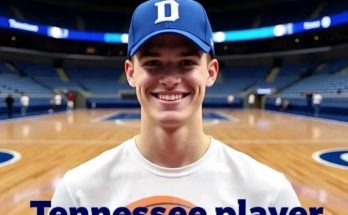Freshman Sebastian Wilkins dazzles in the film room with his size and wing mobility, displaying powerful
Freshman Sebastian Wilkins dazzles in the film room with his size and wing mobility, displaying powerful instincts and a rare blend of athleticism that coaches dream about. Though still in the early stages of his collegiate career, Wilkins already shows flashes of a high-level two-way contributor, a player who might one day anchor both ends of the floor. His frame, standing at 6’8″ with a wingspan nearing 7’1″, allows him to impact plays in ways few freshmen can. Whether he’s gliding in transition, contesting shots on the perimeter, or rotating from the weak side to erase a layup attempt, Wilkins seems to exist in two places at once. But it’s not just the physical gifts—it’s the mind behind the movement, the feel for the game that sets him apart.
Watching Wilkins on film reveals a player who processes the game in real time. He’s not just reacting; he’s reading. He anticipates actions a beat early, slides into help positions before the ball swings, and consistently makes the kind of rotational decisions that are typically expected from seasoned upperclassmen. Defensively, he excels in switch-heavy schemes. His lateral quickness, fluid hips, and long reach make him a nightmare for guards trying to beat him off the dribble. He gets low in his stance, mirrors with his feet, and challenges shots with vertical contests rather than overreaching or lunging. It’s a discipline that belies his age.
Even more impressive is his off-ball defensive IQ. He closes out under control, taking away airspace without overcommitting. He tags rollers, digs on drives, and shows advanced timing as a help defender. There are multiple possessions where he seems to split the difference between two threats, forcing a pass and then recovering in time to challenge the shot. These are the subtle, game-altering sequences that rarely show up on the stat sheet but win possessions—and ultimately games.
Offensively, Wilkins is still growing, but the foundation is strong. His scoring package isn’t fully polished, yet there’s a fluidity to his movements that suggests high long-term potential. His straight-line drives are powerful; when he puts the ball on the floor, defenders bounce off him or scramble to cut off angles. He can absorb contact, adjust mid-air, and finish through length. There’s a natural coordination in how he gathers and extends around the rim, using either hand with surprising comfort for a freshman.
His jumper is developing, with a clean release and repeatable mechanics. The range is already respectable, especially from the corners and wings. While not yet a deadeye shooter, Wilkins doesn’t hesitate to shoot open threes and is beginning to show signs of rhythm off the catch. As he gains confidence and experience, his shot selection has improved, focusing on high-quality looks within the flow of the offense rather than forcing contested jumpers. What’s more encouraging is his willingness to keep defenses honest. He understands spacing, relocates off the ball, and provides just enough of a shooting threat to demand a closeout. That closeout, in turn, opens up his slashing game, where he’s most dangerous.
Perhaps the most surprising aspect of Wilkins’ offensive game is his passing vision. He may not initiate offense or run pick-and-rolls like a guard, but his ability to make the extra pass, find cutters, and execute quick decisions in tight spaces adds value beyond scoring. He recognizes help rotations and finds the open man with timing and precision. These reads—especially from the short corner or high post—are signs of a player who sees the full court and doesn’t rush under pressure. His unselfishness fits seamlessly within ball movement systems, particularly those predicated on drive-and-kick actions or cutting off movement. In transition, he runs the lanes with purpose and keeps his head up, making simple yet effective outlet passes or finishing with authority.
Physically, Wilkins is ahead of the curve. He carries his frame with a mix of strength and agility, a body that seems built for the modern wing role. There’s enough bulk to defend post-ups and enough quickness to chase shooters around screens. His motor never quits, and conditioning doesn’t seem to be a concern. He sprints the floor, rebounds with intent, and competes on every possession. This consistent energy has already earned the trust of his coaching staff, who are unafraid to give him big minutes against experienced competition.
One of the most revealing aspects of his early film is how seamlessly he integrates into different lineups. Whether he’s alongside veteran starters or playing with other underclassmen, Wilkins adapts. He doesn’t need plays run for him to contribute; he finds opportunities through hustle, timing, and smart positioning. On one possession he might be guarding the opposing team’s best scorer, and on the next he’s cutting backdoor for a layup. His game is inherently connective, the kind of style that elevates others by doing the little things that glue together a team.
Of course, there’s room to grow. His handle, while serviceable, can get high under pressure. Against quicker, more physical defenders, he occasionally struggles to protect the ball or create separation in isolation. Improving his first step and tightening his dribble package will be key to unlocking more scoring options in half-court settings. Additionally, while his shot mechanics are solid, extending his range and increasing his shooting volume will add another layer to his offensive versatility. His free-throw shooting is decent, but not yet a weapon. Continued development there would boost his scoring efficiency and allow him to capitalize more on his aggressive driving game.
Defensively, despite his advanced instincts, there are moments where he gambles or over-helps, leading to open shooters. These are teachable moments, signs of a young player still learning the balance between aggression and discipline. With more game reps and film study, these lapses will likely diminish. Coaches rave about his work ethic and coachability—traits that suggest any current weaknesses are temporary, not structural.
It’s easy to get swept up in the excitement of a freshman phenom, but Wilkins appears grounded, focused on the process rather than the hype. His demeanor on the court is calm, almost stoic. He celebrates his teammates’ successes, doesn’t show frustration when calls don’t go his way, and responds to mistakes by locking in on the next play. This emotional maturity, combined with his physical tools and basketball IQ, gives him a steady foundation for long-term success.
Off the court, those close to the program note his studious approach. He reportedly lives in the film room, studying not only his own performances but those of elite wings at the college and pro levels. He’s drawn comparisons to players like Mikal Bridges and OG Anunoby—not just because of similar frames and defensive prowess, but due to their methodical development from raw talents into all-around stars. Wilkins seems to understand that his journey will be defined not by early accolades but by sustained growth. That mindset alone separates him from the average freshman.
In practices, he’s already earned a reputation for his intensity. He competes on every rep, challenges veterans, and doesn’t back down. In scrimmages, he frequently takes the toughest defensive assignments and relishes the challenge. This competitive fire, paired with his team-first mentality, makes him both a reliable contributor and a culture-builder. Teams need players who not only produce but elevate the expectations of those around them. Wilkins fits that mold.
Looking ahead, the ceiling is tantalizing. With another summer in the weight room and continued reps against elite competition, Wilkins could evolve into a primary option. If the jumper becomes more consistent and his handle sharpens, there’s no reason he can’t become a 15-18 point per game scorer while maintaining his defensive impact. His versatility will make him a fit in nearly any system—he can play the 2 through 4 positions, guard multiple spots, and contribute in both uptempo and half-court settings.
Scouts are already watching. NBA front offices covet long, switchable wings who can shoot, defend, and think the game. Wilkins checks all those boxes, even if he’s not yet a finished product. The developmental timeline will vary depending on system and opportunity, but the raw materials are undeniably elite. Whether he declares after one year or stays longer to refine his game, Wilkins is on the radar as a future pro. What makes him special, though, is that he’s not chasing that future at the expense of the present. He plays with purpose in every moment, aware that each possession, each game, is part of something bigger—both for himself and his team.
In a sport full of hype, where potential is too often mistaken for production, Wilkins stands out because his impact is already tangible. He changes games without needing the ball, influences outcomes with effort and intelligence, and improves those around him. Film doesn’t lie, and every minute of tape confirms the same truth: Sebastian Wilkins is the real deal.


